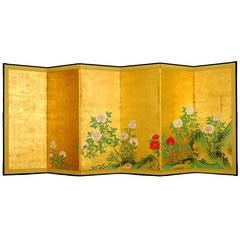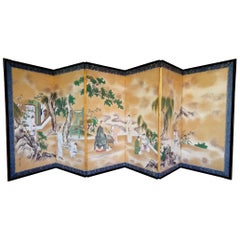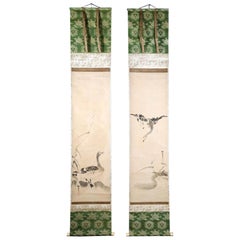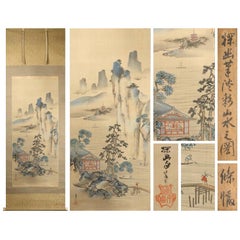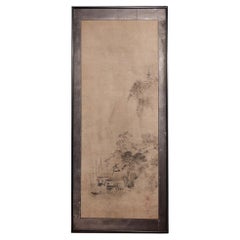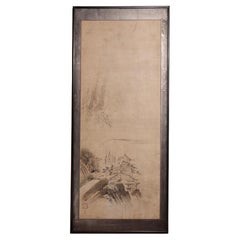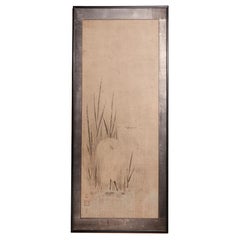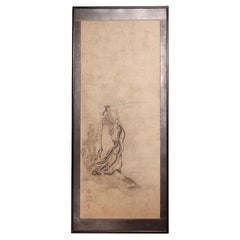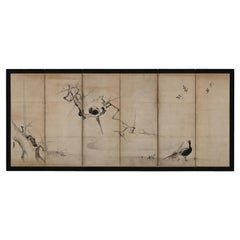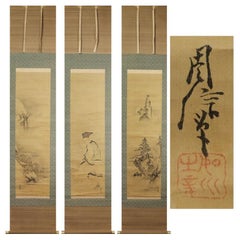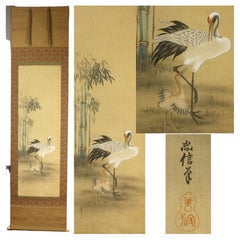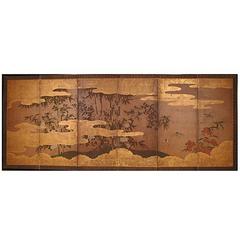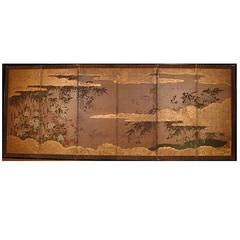17th Century Kano
Antique Late 17th Century Japanese Edo Paintings and Screens
Silk, Wood, Paper
Antique Early 18th Century Japanese Edo Paintings and Screens
Gold Leaf
Antique 17th Century Japanese Japonisme Paintings and Screens
Brass
Antique Late 17th Century Japanese Japonisme Paintings and Screens
Wood, Paper
Antique 17th Century Japanese Edo Paintings and Screens
Silk
Antique 1670s Japanese Edo Paintings and Screens
Paper
Antique 1670s Japanese Edo Paintings and Screens
Paper
Antique 1670s Japanese Edo Paintings and Screens
Paper
Antique 1670s Japanese Edo Paintings and Screens
Paper
Antique 17th Century Japanese Edo Paintings and Screens
Wood, Paper
Antique 17th Century Edo Paintings
Silk
Antique 17th Century Paintings
Silk
Antique 18th Century Edo Paintings
Silk
Antique Late 17th Century Japanese Edo Paintings and Screens
Gold Leaf
Recent Sales
Antique 17th Century Japanese Other Antiquities
Paper
Antique 17th Century Japanese Other Antiquities
Paper
Early 20th Century Chinoiserie Musical Instruments
Antique 18th Century and Earlier Japanese Japonisme Paintings and Screens
Antique 1670s Japanese Edo Paintings and Screens
Paper
Antique 17th Century Japanese Edo Paintings and Screens
Silk
Antique 18th Century and Earlier Japanese Paintings
Antique Mid-17th Century Japanese Edo Paintings and Screens
Paper
Antique 17th Century Japanese Edo Paintings and Screens
Paper
Antique Mid-17th Century Japanese Edo Paintings and Screens
Paper
Antique Late 17th Century Japanese Edo Paintings and Screens
Gold Leaf
Antique 17th Century Japanese Edo Paintings and Screens
Paper
Antique 17th Century Japanese Edo Paintings and Screens
Paper
Antique Mid-17th Century Japanese Paintings and Screens
Paper
Antique Early 17th Century Japanese Paintings and Screens
Paper
People Also Browsed
Vintage 1970s Swiss Mid-Century Modern Sofas
Leather
Vintage 1970s Art Deco Carts and Bar Carts
Late 20th Century Mid-Century Modern Sofas
Fabric
Vintage 1960s American Mid-Century Modern Dining Room Sets
Metal
Antique Late 19th Century Dutch Rococo Jars
Delft
2010s American Modern Cabinets
Brass
Vintage 1930s French Modern Sofas
Mahogany
Vintage 1940s American Hollywood Regency Benches
Gold
21st Century and Contemporary Italian Neoclassical Lounge Chairs
Brass
Vintage 1950s American Mid-Century Modern Slipper Chairs
Wood, Upholstery
Antique Early 19th Century Austrian Biedermeier Sofas
Upholstery, Walnut
Antique Early 1900s Austrian Jugendstil Corner Chairs
Leather, Wood
Antique Early 19th Century Empire Sofas
Wood, Burl
Antique Mid-19th Century French Gothic Revival Jewelry Boxes
Metal, Bronze
2010s English Chippendale Mantel Mirrors and Fireplace Mirrors
Gold Leaf
2010s American Modern Doors and Gates
Brass, Bronze
17th Century Kano For Sale on 1stDibs
How Much is a 17th Century Kano?
Finding the Right Paintings-screens for You
Traditional Asian paintings were often created on scrolls and folding screens. Artisans made screens that could be folded up or spread out by connecting several panels using hinges. Today, antique Asian folding screens and paintings are sophisticated decorative accents that can serve as makeshift partitions to ensure privacy.
The original folding screens were created by Chinese artists. The earliest record of screens comes from the 2nd century B.C., and surviving examples date back to the Ming dynasty. Chinese painting utilizes many of the same tools as calligraphy — these screens were crafted from wood with painted panels featuring striking art or calligraphy that told cultural stories or represented nature and life in the area.
The practice was introduced to Japan, where paintings for screens were made on paper and silk, in the 8th century. These paintings frequently feature subjects such as landscapes, animals, flowers and Buddhist religious themes. Along with screens for tea ceremonies and dance backgrounds, there were screens for use in Shinto and Buddhist temples.
In the 17th century, screens began to be imported to Europe where their popularity grew. Coco Chanel famously collected Coromandel folding screens.
Traditional Asian paintings can make a tasteful addition to any wall, and screens can be used as decoration or, in the case of larger iterations, as an aesthetic way to divide a large room. Browse the selection of antique Asian paintings and screens from a variety of styles and eras on 1stDibs.
- 1stDibs ExpertSeptember 23, 2024What 17th-century furniture is called varies. The general term for all furniture produced 100 years ago, including 17th-century pieces, is antique furniture. You may also choose to be more specific and describe a piece by its style. Theatrical and lavish, the Baroque style was prevalent across Europe from the 17th to the mid-18th century and spread around the world through colonialism, including in Asia, Africa and the Americas. Baroque furniture was extravagant in all aspects, from shape to materials. 17th-century pieces from England often feature characteristics of the William and Mary style, such as crisp lines, maple and walnut veneers, inlaid bands and C-scroll ornaments. On 1stDibs, explore a variety of antique furniture.
- 1stDibs ExpertApril 5, 2022Sir Isaac Newton invented the reflector telescope in the 17th century. He created it as a replacement for the refracting telescope, which tended to have poor optics. Find a collection of antique and vintage telescopes on 1stDibs from some of the world’s top sellers.
- 1stDibs ExpertApril 5, 202217th-century Dutch portraiture has many similarities to other Baroque paintings, including rich colors, dark shadows and intense lighting. Many famous Dutch Baroque works lean toward realism. In Dutch portraiture, props and detailed backgrounds are uncommon. You'll find a collection of Dutch Baroque paintings from some of the world’s top art dealers on 1stDibs.
- 1stDibs ExpertApril 5, 2022Yes, the history of glass-making goes back much further than the 1600s. It’s believed that they were making glass in different parts of the world at least 3,600 years ago, maybe even longer. During the late Bronze Age in Egypt and in Western Asia, glassmarking advanced significantly and was manipulated extensively to produce vessels, jewelry, and works of art. Shop a range of antique and vintage glass on 1stDibs.
- 1stDibs ExpertMarch 22, 2022Yes, there were cannons in the 16th century. The history of the weapon dates back to 12th-century China. Historical records suggest that the first cannons appeared in Europe during the Islamic wars in Iberia in the 13th century. Find a range of antique cannons on 1stDibs.
- 1stDibs ExpertApril 5, 2022What painting is the most important of the 20th century is largely a matter of personal opinion. Some notable works produced during the period include Paul Cézanne's Mont Sainte-Victoire, Pablo Picasso's Les Demoiselles d'Avignon, Henri Matisse's The Dance and Jackson Pollock's Lavender Mist. Shop a large selection of 20th-century paintings on 1stDibs.
- 1stDibs ExpertApril 5, 2022A variety of furniture was used during the 16th century. Items commonly found in homes include high-backed armchairs, chests, stools, benches and cupboards. Most European artisans active during the time period produced pieces out of oak wood. Find a large collection of antique furniture on 1stDibs.
- 1stDibs ExpertNovember 13, 2024To identify 18th-century furniture, you can research your piece in the context of the prevailing styles of the period or consult a certified appraiser or experienced antique dealer. To identify your item on your own, look over it for maker's marks, such as carvings, stamps, brands and labels. Researching the marking can help you determine the maker of your piece, and from there, you can search further to learn more about your particular item. Without a maker's mark, the best approach is to consider the characteristics of the dominant furniture styles during the 18th century. In England, these included William and Mary, Queen Anne, Georgian, Chippendale, Hepplewhite and Sheraton. Some French furniture styles of the 1700s include Louis XV, Louis XVI and Régence. Find a diverse assortment of 18th-century furniture on 1stDibs.
- 1stDibs ExpertApril 5, 2022Yes, wedding rings have a long history, stretching back to ancient Egypt. The first diamond engagement ring was created in 1477 by Archduke Maximillian of Austria. Browse a wide array of vintage and contemporary wedding rings on 1stDibs.
- 1stDibs ExpertApril 5, 2022In the 18th century, art changed in style from Baroque to Rococo and Neoclassicism. Art became more ornamented and idealized during the Rococo period and then shifted toward a style that emulated the artwork of ancient Greece and Rome near the end of the century. You’ll find a variety of fine art on 1stDibs.
- 1stDibs ExpertApril 5, 2022One way to check if your brass candlesticks are from the 18th century is to look for the two seams running lengthwise on either side. This is from when the candlestick was molded in two halves and then soldered together. You’ll find a variety of candlesticks of all shapes and sizes from some of the top sellers on 1stDibs.
- 1stDibs ExpertApril 5, 2022British artist John Singer Sargent was one of the most important portrait painters of the 19th century. Other notable portraitists from the period include James Abbott McNeill Whistler, Eugène Delacroix, Théodore Géricault, Gustave Courbet, Édouard Manet, Mary Cassat, Claude Monet and Pierre-Auguste Renoir. On 1stDibs, find a wide variety of portrait paintings.
- 1stDibs ExpertJanuary 10, 2025The individuals considered the Big Three of 18th-century cartoons are William Hogarth, James Gillray and George Cruikshank. Although the 18th century saw a widespread increase in illustrations in newspapers, these three illustrators were particularly well-known for their work. Hogarth's work was extremely diverse, ranging from serious, realistic paintings and portraits to satirical and moralistic illustrations filled with symbolism. A British caricaturist, Gillray is remembered today for his artworks representing political and social satires, like his political cartoons against George III of England. Despite being a prolific caricaturist, Cruikshank is now most famous for illustrating the works of Charles Dickens. On 1stDibs, find a wide variety of illustrations.
- 1stDibs ExpertApril 5, 2022The French painters of the 19th century worked in two styles. Neoclassicism dominated the first half of the century, and Impressionism was the most common style during the second half. On 1stDibs, you can find a variety of French paintings.
- 1stDibs ExpertApril 5, 2022At the end of the 17th century, Europe went into a frenzy over porcelain. Asian porcelain was highly sought after, and spurred the foundation of the Meissen factory in France, where hard porcelain went on to be made. You’ll find a large collection of porcelain pieces from many of the world’s top sellers on 1stDibs.
Read More
Symbols of Happiness and Rebirth Adorn This Japanese Satsuma Bowl
Decorated with white cranes and the sought-after thousand-butterflies motif, the Meiji-period vessel offers both a celebration of traditional aesthetics and a clear reflection of the era’s appetite for exquisite export pieces.
Chicago’s Pagoda Red Has a Spirited Mix of Asian Antiques and Bold New Art
For 25 years, gallerist Betsy Nathan has leveraged her keen eye and key connections to bring a unique selection of rare finds to the market.
In L.A., Gallerist JF Chen Has Long Championed Eclectic Blue-Chip Design
Now working alongside his daughter Bianca, dealer Joel Chen has presented a most covetable array of antiques, art and contemporary creations for more than 40 years.
12 Calming Spaces Inspired by Japanese Design
From cherry-blossom-adorned walls paired with glamorous lighting to wood-paneled ceilings above checkerboard-patterned chairs, these 12 spaces seamlessly blend Eastern and Western aesthetics.
Rodrigo Rivero Lake’s Mexico City Showroom Is a Museum-Worthy Trove of Spanish Colonial and Asian Antiques
The dealer and curator has spent the past 50 years amassing a collection of exceptional art, furniture and architectural elements that trace the cultural influence of the Spanish empire from Europe to the Americas and beyond.
16 Refined Asian-Inspired Interiors
These spaces exemplify how Eastern elements elevate a home's decor.

